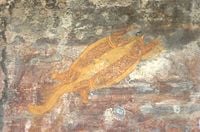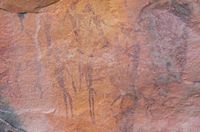Cave painting
Cave or Rock Paintings are paintings on cave or rock walls and ceilings, usually dating to prehistoric times. The earliest known rock paintings are dated to the Upper Paleolithic, 40,000 years ago, while the earliest European cave paintings date to 32,000 years ago. The purpose of the cave paintings is not known, and may never be. The evidence suggests that they weren't merely decorations of living areas, since the caves in which they've been found don't have signs of ongoing habitation. Also, they are often in areas of caves that aren't easily accessed. Some theories hold that they may have been a way of transmitting information, while other theories ascribe them a religious or ceremonial purpose.
Technique
Cave paintings are a form of Rock art, falling under the category of pictograph, or the application of pigments to a rock surface. Survival of ancient cave paintings is attributable to use of mineral pigments, most commonly manganese, hematite, malachite, gypsum, limonite, clays and various oxides. The best preserved pictography is found under sheltering overhangs and in caves. The simplest pictographs are wet clay finger drawings and charcoal drawings. To produce crayons or paints first the minerals had to be finely ground and combined with binding materials. Crayons and animal hair brushes have been excavated in caves with paintings. Exceedingly fine lines evidence the production of excellent brushes. The most common rock art element found around the world, the human hand, exemplifies several pictography types. A technique used since the Neolithic is spraying around a hand, resulting in a negative image. The more common positive print was often made with pigment applied to the hand and transferred to the rock.
Interpertation
What rock art means and why the ancients practiced it has been a bane of contention amongst scholars since the phenomena started to be studied. Some have argued that such images are records of hunts that served not only to inventory the amount of animals killed as well as future references for animal migrating patterns.[1] Henri Breuil interpreted rock paintings as being hunting magic, meant to increase the number of animals killed by hunting parties.[2]
An alternative theory, developed by David Lewis-Williams and broadly based on ethnographic studies of contemporary hunter-gatherer societies, is that the paintings were made by Cro-Magnon shamans. The shaman would retreat into the darkness of the caves, enter into a trance state and then paint images of their visions, perhaps with some notion of drawing power out of the cave walls themselves. This goes some way toward explaining the remoteness of some of the paintings (which often occur in deep or small caves) and the variety of subject matter (from prey animals to predators and human hand-prints).
R. Dale Guthrie has studied not only the most artistic and publicized paintings but also a variety of lower quality art and figurines, and he identifies a wide range of skill and ages among the artists.[3] He also points out that the main themes in the paintings and other artifacts (powerful beasts, risky hunting scenes and the over-sexual representation of women in the Venus figurines) are to be expected in the fantasies of adolescent males, who made a big part of the human population at the time. However, according to Merlin Stone in her book When God Was a Woman, many scholars and archaeologists impose modern sexist views on ancient findings.[4] Considering the prevalence of Goddess worship (beginning between 7,000 and 25,000 B.C.E.), it is much more probable that art depicting the fullness of a woman's body was not a teenage male's fantasy but reproductions done in praise of women by artists of either sex.[5] As with all prehistory, it is impossible to be certain because of the relative lack of material evidence and the many pitfalls associated with trying to understand the prehistoric mindset.
Graham Hancock's Supernatural: Meetings with the Ancient Teachers of Mankind explores the various theories on the interpretation of rock art, and provides extensive references. He concludes that recent theory linking shamanic and religious practices with cave painting throughout the world appear the most credible.[6]
Cultural Variants
Europe
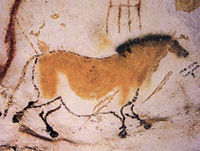
This image has an uncertain copyright status and is pending deletion. You can comment on the removal.
The first cave paintings to be discovered were in Europe, where soon afterwards, many more sites uncovered. Some of the most famous European sites are:
- Lascaux, France
- La Marche, near Lussac-les-Chateaux, France
- Chauvet Cave, near Vallon-Pont-d'Arc, France
- Altamira, near Santillana del Mar, Cantabria, Spain
- Cosquer Cave, with an entrance below sea level near Marseille, France
- Font de Gaume, in the Dordogne Valley in France
Rock painting was also performed on cliff faces, but fewer of those have survived because of erosion. One well-known example is the rock paintings of Astuvansalmi in the Saimaa area of Finland.
Age
Nearly 350 caves have now been discovered in France and Spain that contain art from prehistoric times. The age of the paintings in many sites has been a contentious issue, since methods like radiocarbon dating can be easily misled by contaminated samples of older or newer material[citation needed], and caves and rocky overhangs (parietal art) are typically littered with debris from many time periods. Recent advances make it possible to date the paintings by sampling the pigment itself. [2]
The choice of subject matter can also indicate date such as the reindeer at the Spanish cave of Cueva de las Monedas which imply the art is from the last Ice Age. The oldest cave is that of Chauvet, and is 32,000 years old.[3] Other examples may date as late as the Early Bronze Age, but the well known prolific and sophisticated style from Lascaux and Altamira died out about 10,000 years ago, coinciding with the advent of the neolithic period.
Themes and patterns
The most common themes in cave paintings are large wild animals, such as bison, horses, aurochs, and deer, and tracings of human hands as well as abstract patterns, called finger flutings. Drawings of humans are rare and are usually schematic rather than the more naturalistic animal subjects. Cave art may have begun in the Aurignacian period (Hohle Fels, Germany), but reached its apogee in the late Magdalenian (Lascaux, France).
The paintings were drawn with red and yellow ochre, hematite, manganese oxide and charcoal. Sometimes the silhouette of the animal was incised in the rock first.
Africa
At Ukhahlamba-Drakensberg, South Africa, now thought to be some 3,000 years old, the paintings by the San people who settled in the area some 8,000 years ago depict animals and humans, and are thought to represent religious beliefs.
Recently, an archeological team discovered the Laas Gaa'l cave paintings outside Hargeisa in Somaliland. They show the ancient inhabitants of the area worshipping cattle and performing religious ceremonies.
Cave paintings are found in the Tassili n'Ajjer mountains in southeast Algeria also in the Akakus, Messak Settafet and Tadrart in Libya and other Sahara regions including: Ayr mountains, Niger and Tibesti, Chad.
Mexico
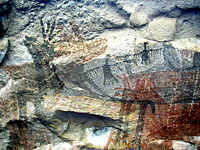
The Rock Paintings of Sierra de San Francisco is the name given to prehistoric rock art found in the Sierra de San francisco region of Baja California, Mexico, created by a people referred to as Cochimi or Guachimis. There are some 250 sites which are located in the municipality of Mulege within the El Vizcaino Biosphere Reserve in the state of Baja California Sur in Northern Mexico. Motifs include human figures, weapons, and animal species such as rabbit, puma, lynx, deer, wild goat/sheep, whale, turtle, tuna, sardine, octopus, eagle, and pelican; there are also abstract elements of various forms. The paintings vary in age from 1100 B.C.E. to AD 1300.
The paintings are noted for their high quality, extent, the variety and originality of human and animal representations, remarkable colors, and excellent state of preservation. The rock paintings of Sierra de San Francisco were nominated in 1989 and became a World Heritage Site in 1993.
Australia
Significant early cave paintings have also been found in Kakadu National Park in Australia.
The park has a large collection of ochre paintings. Ochre is a not an organic material, so carbon dating of these pictures is impossible. Sometimes the approximate date, or at least, an epoch, can be guessed from the content.
- Rock painting fishes.jpg
Fishes—an X-ray style painting—with some internal organs shown in detail.
Southeast Asia
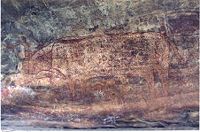
There are rock paintings in caves in India,[7] Thailand, Malaysia and Indonesia. In Thailand, caves and scarps along the Thai-Burmese border, in the Petchabun Range of Central Thailand, and overlooking the Mekong River in Nakorn Sawan Province, all contain galleries of rock paintings. In Malaysia the oldest paintings are at Gua Tambun in Perak, dated at 2000 years, and those in the Painted Cave at Niah Caves National Park are 1200 years old. See prehistoric Malaysia. In Indonesia the caves at Maros in Sulawesi are famous for their hand prints, also found in caves in the Sangkulirang area of Kalimantan.
Notes
- ↑ Chippindale, Christopher (Ed) and Paul S. C. Taçon (Ed). The Archaeology of Rock-Art, (Cambridge University Press 1998) ISBN 0521576199
- ↑ "Breuil, Henri." Encyclopædia Britannica. 2007. Encyclopædia Britannica Online. 7 Dec. 2007 [1]
- ↑ Guthrie, R. Dale The Nature of Paleolithic Art, (University Of Chicago Press, 2006) ISBN 978-0-226-31126-5.
- ↑ Stone, Merlin. When God Was a Woman, (Harvest Books 1978) ISBN 015696158X
- ↑ Stone, Merlin. When God Was a Woman, (Harvest Books 1978) ISBN 015696158X
- ↑ Hancock, Graham. Supernatural: Meetings with the Ancient Teachers of Mankind, (Disinformation Company 2007) ISBN 1932857842
- ↑ Rock Shelters of Bhimbetka. World Heritage Site. Retrieved 2007-02-15.
ReferencesISBN links support NWE through referral fees
- Thomas Heyd and John Clegg, eds. Aesthetics and Rock Art. Ashgate Publishing, Aldershot, England and Burlington, VT, USA. 2005. ISBN 0-7546-3924-X
- Gregory Curtis, The Cave Painters: Probing the Mysteries of the World's First Artists, Knopf, New York, NY, USA, 2006. 1-4000-4348-4
External links
- Bradshaw Foundation The recording of cave paintings around the world
- EuroPreArt database of European Prehistoric Art
- Malaysian Caves
- Cave paintings in Castell de Castells Spain
- American Rock Art Research Association
Credits
New World Encyclopedia writers and editors rewrote and completed the Wikipedia article in accordance with New World Encyclopedia standards. This article abides by terms of the Creative Commons CC-by-sa 3.0 License (CC-by-sa), which may be used and disseminated with proper attribution. Credit is due under the terms of this license that can reference both the New World Encyclopedia contributors and the selfless volunteer contributors of the Wikimedia Foundation. To cite this article click here for a list of acceptable citing formats.The history of earlier contributions by wikipedians is accessible to researchers here:
The history of this article since it was imported to New World Encyclopedia:
Note: Some restrictions may apply to use of individual images which are separately licensed.

